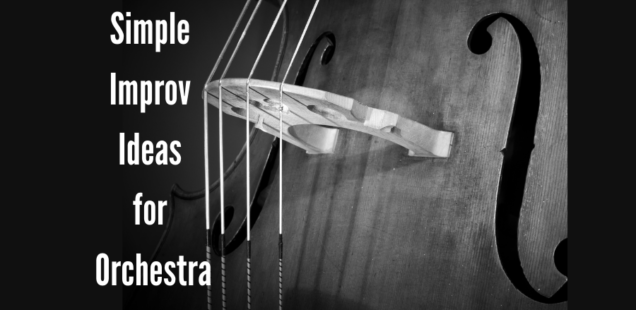
Simple Improv Ideas For Orchestra
This past summer I pursued an idea I have been ruminating about for a long time - a jazz string camp. I called it the String Improv Workshop. You can read more about it here. I had a small, but mighty group of students who showed up for 2 weeks over the summer to explore improvisation, jazz, and learn new music.
For some background, I’ve long been incorporating jazz and improvisation when I can into my orchestra classroom. I’ve written about some simple ways to encourage improv in your classroom on the blog. You can check out those articles here and here.
In fact, several years ago (prior to the pandemic) I started an after school club called the Jazz String Ensemble. You can read about how to start one of your own here. The goal of that ensemble, just like the Jazz String Workshop, was to introduce students to improvisation and jazz.
If you are curious about how to incorporate improvisation into your string program, I want to share with you some of the activities I did with the students this summer at the String Improv Workshop. They are very simple and accessible (even if you don't feel like improvisation is a strong suit). With these simple improv ideas, you can help your students begin exploring how to improvise.
Get Started
Since most of my students have never really explored improvisation, I always start with a conversation about what improvisation is.
They share their ideas and I do as well. I tell them improvisation is taking what you know and creating something new in the moment, except it isn’t just purely random. I tell them to get better at improvising they have to work it just as they would any other muscle! Great improvisers and jazz musicians work on musical ideas and melodies that can be used to improvise with. I explain to them that improvisation is like taking words and then stringing those words together into sentences and then those sentences become a story! The words are the notes, scales, and musical ideas they already know that can then be used to create the sentences and ultimately a story.
Try Out These Ideas
So here are a few of the ideas I tried with my students in the Jazz String Workshop this past summer. All of these ideas center around experimenting with a scale (of your choice). Your students know scales, so why not foster a sense of creativity with those scales? Try out these ideas in your classroom.
- Scale With Improvised Rhythm
- Directions: Start with a scale of your choice. Play the scale up and back down with the notes in order. Improvise by varying the rhythm only. Keep the order of the notes. Use quarter notes, 8th notes, half notes, or any other rhythmic combinations you can create.
- Repetition:
- Directions: Start with a scale of your choice. Play it up and down to review the pitch notes. Now, repeat each note of your scale two, three, or four times. Play the scale notes in order, up and back down, but improvise using repetition of each scale note.
- Short Melodies:
- Directions: Start with a scale of your choice. Play it up and down to review the pitch notes. Begin to improvise by creating short melodies using only a few of the notes from the scale. For example, play only the 1st and 2nd scale degrees and vary the rhythm. Explore even further by playing the 1st, 2nd, and 3rd scale degrees and vary the rhythm. You get the idea! Create your own short melodies using the notes of your scale.
- Patterns:
- Directions: Start with a scale of your choice. Play it up and down to review the pitch notes. Begin to improvise by creating a repeated melodic pattern. For example, play the 1st, 2nd, and 3rd notes of the scale, then the 2nd, 3rd, and 4th notes of the scale, then the 3rd, 4th, and 5th notes of the scale. Keep going in this pattern. Have your students think up their own patterns, collaborate, or work as a class to develop an original pattern.
- Change Directions:
- Directions: Start with a scale of your choice. Play it up and down to review the pitch notes. To improvise, change directions (ascending or descending) at any point as you play the scale. For example, ascend up the scale to the 5th degree, then come back down to the 3rd degree, then back up. Continue to change direction at any point as you play the scale.
Conclusion
With these simple ideas, you will find that students will gain confidence and feel empowered to try new things musically. One final suggestion is, if you have a backing track set in a particular key, it is fun for students to then use these ideas over a simple vamp. If you don’t have a backing track, try making up a vamp on piano for students to experiment over.
Additionally, these ideas don’t take away from any of the skills we are trying to teach as educators - in fact, they only reinforce them in even more powerful and meaningful ways for our students. Instead of just playing a scale up and down, students must now create with and apply their knowledge of that scale. This makes for a deeper connection with the content. So give improvisation a try in your classroom.
Check It Out!
Take a look at the Jazz Basics: Common Chord Progressions for both treble clef and bass clef. This resource will help students practice over one of the most common chord progressions in jazz, the I vi ii V I.
Students can play the roots, arpeggiate, or walk bass lines through the chord progression in all twelve keys.
Jazz Basics: Common Chord Progressions For Bassists and Bass Clef Instruments and Jazz Basics: Common Chord Progressions For Treble Clef Instruments.

